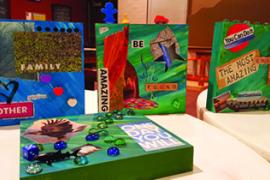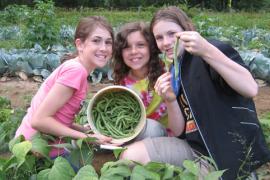Another way to increase usage at camp facilities is to allow people to bring their own horses to camp. Both youth and adults will have this interest and appreciate having a location to camp with their equine friend. Attending camp with a horse can strengthen the understanding and communication between the two and four-legged members of the team. The therapeutic value of horses at camps is well documented. (See the March/April 2004 Camping Magazine article, "Equestrian Programs at Camp—Tradition and Fun.")
Over 400,000 4-H youth attend camps annually (Garst & Bruce 2003). Utilizing the knowledge of 4-H staff and the structure of 4-H horse projects by inviting these campers to bring their horses can be a beneficial addition to any camp schedule. Since 2002 the Oregon 4-H Center has added a 4-H members horse camp to the summer activities.
Project Context
Nationwide participation in 4-H horse projects is growing each year. In Oregon in 2005, over 4,100 members enrolled in horse projects. Over 21 percent of all Oregon 4-H projects are horses, up from 17 percent in 2001. Over 90 percent of horse project youth compete at fairs and shows. About half of members live in cities, where they board their horses. As open spaces are reduced, so is the amount of land available for trail riding. Some riders never venture outside a fenced arena, because of a lack of outdoor riding space. Horses and riders used to being in a confined space may not be mentally (or physically) suitable for riding beyond fenced boundaries. Riding through brush, over rough terrain, and a long way from the barn requires confidence and analytical and technical skills to handle the mount. Horses are also prone to physical injury (i.e., leg sprains, cuts, etc.). Youth frequently aren't taught to deal with emergency veterinary injuries that can incur on a trail ride. One solution is to encourage youth to take their horses to camp.
Background
In 2002, the Oregon 4-H horse members' camp began. 4-H horse club members from around the state were invited to take their horses to the Oregon 4-H Center, which has a designated horse camping area.
The horse camp is a separate facility located a five-minute walk away from the core area at the Oregon 4-H Center. Horse camp consists of a large historical barn, a grassy meadow, a 100' x 200' fenced riding arena, water troughs by the barn and arena, tack shed, bunkhouses, covered tie stall barn for forty horses, and a shower house with a small kitchen. Individual outdoor corrals were just built for overnight horse stabling. There are scenic and safe riding trails around the 320-acre facility.
Even for camps which don't have such extensive amenities, horses can still be included in the camp structure. Wilderness management techniques such as keeping horses on overhead "tie lines," and portable corrals provide temporary housing for the animals. When horses are on the camp property, specific risk management plans must be implemented. 4-H horse project members are covered by an accident insurance at any camp they attend.
What's the Point?
Any camp with space for the thousand-pound equine can hold horse camps focused on educational activities. 4-H is a youth development organization which emphasizes utilizing projects (i.e., horses) as the tools for life skills. With this in mind, the objectives of having horses at camp are:
- Allow youth to partner with their equine in a noncompetitive natural atmosphere.
- Instill environmental awareness and low-impact ethics in young riders.
- Develop confidence and competency in dealing with equine medical emergency first aid.
Up to twenty-six youth, ranging from fourth to twelfth grade, have participated each of the past four years. The enrollment numbers are limited for safety and to allow individual attention. The American Camp Association (ACA) Accreditation Process Guide has a section on horseback riding. As in other specialized program activities, safety is a central concern. ACA's Horseback Riding standards set high expectations for trained supervision, appropriate instruction, safety precautions, and well-planned emergency procedures. ACA standards closely align with 4-H rules. All riders are required to wear ASTM certified helmets when mounted. Since youth are bringing their own helmets, the risk of head lice transmission is minimal. When helmets are supplied for riders, they should be sprayed with an approved insecticide. Horses are examined for general health and transmissible diseases upon arrival. If there are concerns, e.g., ringworm, the horse is not allowed to remain at camp. Appropriate footwear must be worn when handling horses or riding. Horse leaders in 4-H are trained to work with youth education and understand horses. These experienced adults with seasoned trail horses are involved in all aspects of the camp—from planning and implementation, to evaluation.
Program Contents
People love to share their passion and expertise about equines. Over the years a variety of organizations and professionals have been recruited to teach at the camp. To emphasize the Leave No Trace educational portion, hands-on demonstrations are provided by certified instructors from equestrian trail organizations. The Backcountry Horsemen of America have chapters in many states with volunteers who attend camps and provide educational programming. At the Oregon camp, horse and mule packers with the U.S. Forest Service are guest speakers. Campers are treated to meeting pack animals, practicing balancing loads on the mules, seeing what a wilderness camp entails, and learning low-impact camping techniques—all in a field at the 4-H Center. Fancy facilities aren't needed to replicate the wilderness equine experience at any camp.
Senior students from the university veterinary school teach hands-on emergency first aid classes. The key concept emphasized is that every person needs to take responsibility for dealing with equine medical emergencies. When out in remote areas, it's not realistic to call 9-1-1 and hope for help! Campers are taught to take their own horse's temperature, pulse, and respiration; to stop bleeding; and to wrap injured legs. Some of the campers don't want to take their horse's rectal temperature, but horses won't hold a thermometer under their tongue. Experienced horse handlers assist the youth in safely taking temperatures.
Project Outcomes: Survey Results
In 2002, a general evaluation of twenty-six youth was done at camp and then again five months later. Youth reported gaining general horse knowledge, new ideas, new skills—and they learned to apply these new skills. When asked what benefits have resulted from attending the camp they reported feeling more comfortable riding on the trail and being competent to handle emergency first aid.
At camp in 2003, twenty-three campers completed pre and post tests. Questions covered knowledge, attitudes, skills, and actions. Significant differences are seen in each area in a majority of campers. For example:
- Understanding low-impact camping
- Feeling confident to take a horse's three vital signs (temperature, pulse, and respiration)
- Conditioning the horse before hard rides
- Being comfortable teaching trail riding to others
Six months later a follow-up survey was completed. An 82 percent return rate (19/23) showed that the youth retained what they had learned and were using their knowledge when trail riding. This finding was especially significant because riders reported they were making changes in their riding habits during the winter, when most trail tread damage occurs.
The high return rate was partially a result of a phone follow-up after two written surveys had not been returned. In the phone interview, questions were read to the camper directly from the survey. One question was, "If your horse looked sick, could you take its vital signs? Then, "Name two vital signs." On the phone, the camper responded that she couldn't remember. The next question was, "What did you learn at camp which you taught to others?" The young lady proudly responded that she helped other 4-H club members learn to take their horses' pulse and temperature—two vital signs! She just hadn't understood the terms in the question.
In 2006, a slightly different format was used. 4-H horse project members and their families were invited to bring their horses to the Oregon 4-H Center for a long weekend. Instead of focusing on structured educational activities, the theme was a work party. The participants worked, rode, and played hard. They cleared brush from trails, put gravel into stalls, fixed fences, etc. The camp was physically benefited by the campers' attendance—a welcome twist for any facility!
Benefits of Horses at Camp
Camps and campers both benefit by allowing campers to bring their own horses to camp for educational, structured events. There are a growing number of 4-H horse project members who don't have the opportunity to ride their horse in a "natural" outdoors environment. They need and deserve to enjoy nature and riding safely, with knowledge of protecting themselves, their horse, and the environment. The 4-H horse camp addressed all these issues in a relaxed, noncompetitive way. The format used in Oregon can be easily modified anywhere.
| Reference |
|
Garst, B. and F.A. Bruce. 2003. Identifying 4-H camping outcomes using a standardized evaluation process across multiple 4-H educational centers. Journal of Extension, 41.
|
|
Equine Risks Risk Identification
Discussion
Risk Control Consult with your insurance agent/broker and legal counsel to ensure that incorporating this model into your camp equine program includes a thorough examination of the risks. Develop and implement a customized risk management plan that protects you and your organization’s assets. |
Robin Galloway is a 4-H youth development associate professor with Oregon State University in Linn County, Oregon. She works with both day and residential camps at the Oregon 4-H Center near Salem, Oregon.
Daniel McGrath is a former 4-H agent and professor with OSU Extension.
Originally published in the 2007 September/October issue of Camping Magazine.


